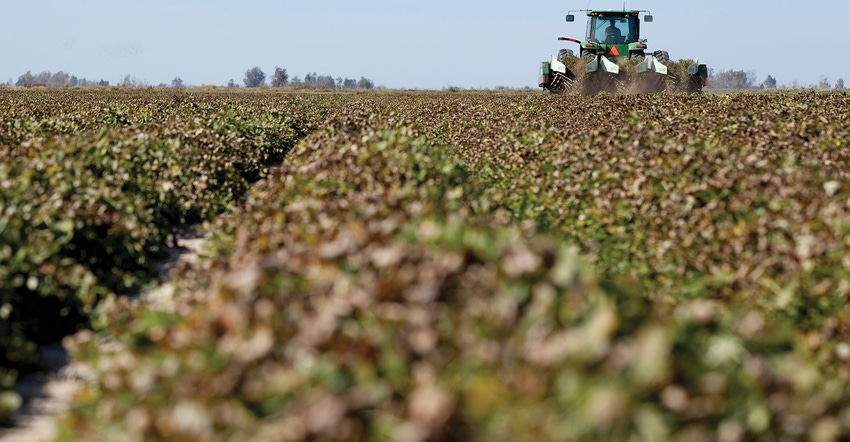July 31, 2020

As 2020 peanut prices gradually catch up to those offered in 2019, the popular legume, now planted in an estimated 35,000 to 36,000 acres across Arkansas, continues to look like an increasingly good bet for growers with soil beset by southern root-knot nematodes or low nutrient values.
The crop often serves to kill two or more birds with one stone, redeeming otherwise unusable land and keeping input costs low, said Andy Vangilder, agriculture and natural resources Extension educator for the University of Arkansas System Division of Agriculture.
“The real draw for a lot of peanut farmers here is, you grow it on your sorriest ground,” Vangilder said. “Not everywhere — in Marianna, for example, they grow it on some of their really good cotton dirt, and they make really good yields. But up in Mississippi and Craighead counties, and even in Clay County this year, we put it on our really sorry, sandier, southern root-knot nematode-infested ground, because the peanut isn’t affected by that pest.”
Peanut acreage in Arkansas has fluctuated over the past decade, dipping from about 18,000 acres in 2012 to about 10,000 acres in 2014, then steadily climbing since. In Arkansas, the leading peanut counties include Mississippi and Craighead counties, with smaller acreages in Greene, Lee, St. Francis and other counties in the Delta region.
From early August 2019 through early December, peanut prices in the United States generally lagged behind prices of the previous year by as much as 4 cents per pound. By February 2020, markets had pulled even or even passed the previous year’s prices in some weeks, and by the end of June, growers were seeing prices above 20 cents per pound. During the week ending June 27, growers sold approximately 82.4 tons of peanuts, nearly all of which were “runner-type” peanuts — the kind most commonly grown in Arkansas and elsewhere.
Profitable crop
“Peanuts are one of our most profitable crops right now” in terms of input-to-cash receipts, Vangilder said. “The inputs are not quite as high as other crops, and the profit margin is probably better than any of them, depending on your yield.”
Peanuts offer attractive margins for growers who can take advantage of them, said Scott Stiles, Extension economist for the Division of Agriculture.
“At just under $500 per acre, variable costs for peanuts are less than rice, corn or cotton,” Stiles said. “However, fixed costs for peanut production is highest among the major crops grown in the state at $193 per acre. Total cost of production is about $692 per acre — still less than rice and cotton and comparable to corn.”
Fixed costs are associated with equipment and machinery — peanuts require some very crop-specific machines, including diggers, combines and “fluffers,” which lift the dug peanuts off the ground for drying — in addition to irrigation wells.
Stiles said current estimates put the average farm price for peanuts at $410 a ton.
“Consumer demand has been strong for products like peanut butter due to more stay-at-home eating,” he said. “The USDA is forecasting a 2.5 percent increase in domestic food use of peanuts in the current marketing year.”
Strong competitor
Of course, the value of a crop is measured in more than just its own profitability — it has to be considered in the context of competing crops. And while peanuts are a strong competitor in that context, they have the added benefit of restoring soil through nutrient deposits, and also by way of starving off pest populations, particularly the southern root-knot nematode, which often bedevils cotton crops but is a non-issue to peanuts.
“If you have ground that’s really infested with root-knot, that doesn’t produce other crops well, you can put a crop of peanuts in there, and they’ll grow really well,” Vangilder said. “Then you can come back with soybeans, cotton or corn. Our cotton producers typically see a 100- to 200-pound lint increase per acre by doing this.”
“Last year Arkansas’ average peanut yield was 5,200 pounds or 2.6 tons per acre,” Stiles said. “At $410 a ton, that could deliver gross revenue of $1,066 per acre. When corn is $3.50, soybeans are $8.50 and cotton is 50 cents, having the ability to shift some acres to peanuts can be very beneficial.”
No matter how well the growing season goes, any crop can ultimately be fouled by bad harvest conditions, and peanuts are no exception. Because harvesting the legumes is a two-step process, involving both digging them from the ground, then later collecting them once they’ve dried out, they are particularly vulnerable to wet weather.
“Bad weather can be very detrimental to peanuts in harvest,” Vangilder said. “When it’s wet, it’s a problem, getting peanuts out of the ground. You can’t dig them out, and you can’t run them through a combine.
“It’s a profitable crop, but it’s a higher-risk crop,” he said.
Source: University of Arkansas System Division of Agriculture, which is solely responsible for the information provided and is wholly owned by the source. Informa Business Media and all its subsidiaries are not responsible for any of the content contained in this information asset.
About the Author(s)
You May Also Like






